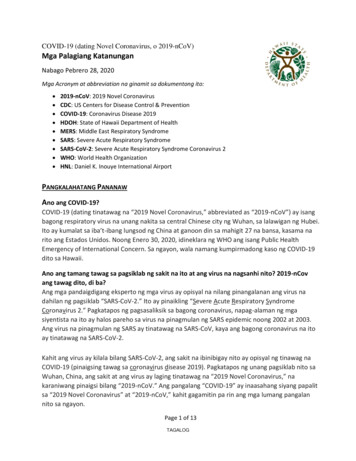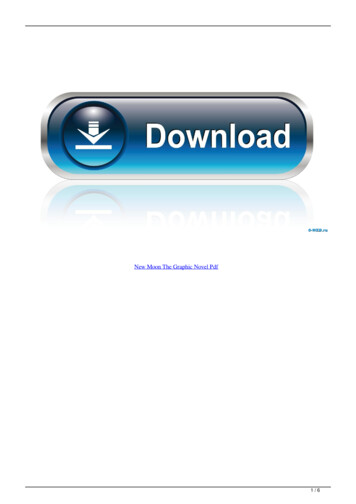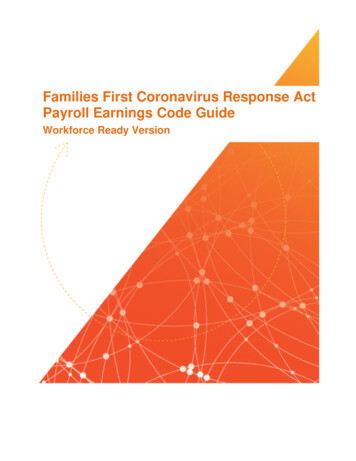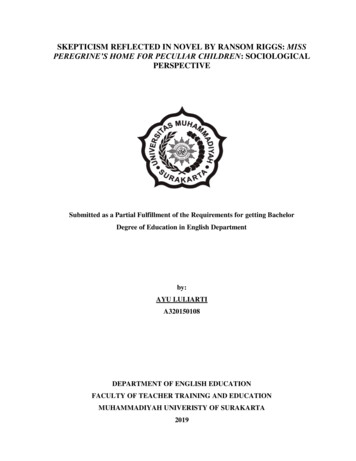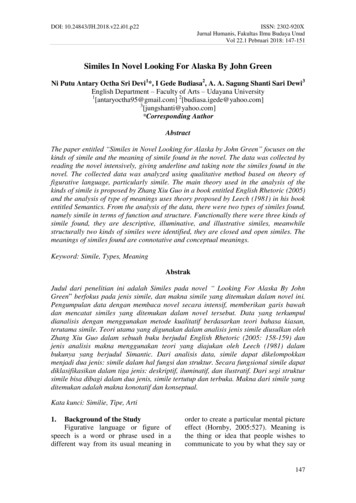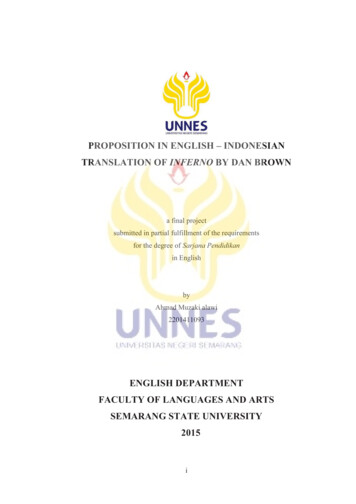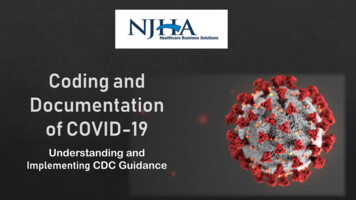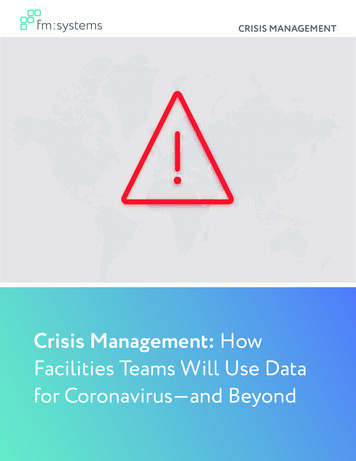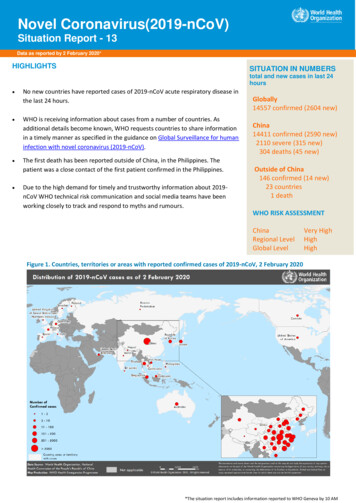
Transcription
Novel Coronavirus(2019-nCoV)Situation Report - 13Data as reported by 2 February 2020*HIGHLIGHTSSITUATION IN NUMBERStotal and new cases in last 24hours No new countries have reported cases of 2019-nCoV acute respiratory disease inthe last 24 hours. WHO is receiving information about cases from a number of countries. Asadditional details become known, WHO requests countries to share informationin a timely manner as specified in the guidance on Global Surveillance for humaninfection with novel coronavirus (2019-nCoV). The first death has been reported outside of China, in the Philippines. Thepatient was a close contact of the first patient confirmed in the Philippines. Due to the high demand for timely and trustworthy information about 2019nCoV WHO technical risk communication and social media teams have beenworking closely to track and respond to myths and rumours.Globally14557 confirmed (2604 new)China14411 confirmed (2590 new)2110 severe (315 new)304 deaths (45 new)Outside of China146 confirmed (14 new)23 countries1 deathWHO RISK ASSESSMENTChinaRegional LevelGlobal LevelVery HighHighHighFigure 1. Countries, territories or areas with reported confirmed cases of 2019-nCoV, 2 February 2020*The situation report includes information reported to WHO Geneva by 10 AM
TECHNICAL FOCUS: Risk communication and community engagementManaging the 2019-nCoV ‘infodemic’The 2019-nCoV outbreak and response has been accompanied by a massive ‘infodemic’ - an over-abundance ofinformation – some accurate and some not – that makes it hard for people to find trustworthy sources and reliableguidance when they need it.Due to the high demand for timely and trustworthy information about 2019-nCoV, WHO technical riskcommunication and social media teams have been working closely to track and respond to myths and rumours.Through its headquarters in Geneva, its six regional offices and its partners, the Organization is working 24 hours aday to identify the most prevalent rumours that can potentially harm the public’s health, such as false preventionmeasures or cures. These myths are then refuted with evidence-based information. WHO is making public healthinformation and advice on the 2019-nCoV, including myth busters, available on its social media channels (includingWeibo, Twitter, Facebook, Instagram, LinkedIn, Pinterest) and website.Country risk communication and community engagement (RCCE) preparedness and responseCountry risk communication and community engagement (RCCE) is a critical public health intervention in allcountries. Countries should prepare to communicate rapidly, regularly and transparently with the population. Allcountries should prepare existing public health communication networks, media and community engagement staffto be ready for a possible case, and for the appropriate response if this happens. Countries should coordinatecommunications with other response organizations and include the community in response operations. WHO standsready to coordinate with partners to support countries in their communication and community engagementresponse.Ensuring a people-centered response to 2019-nCoVAn expanding group of global response organization such as the United Nations Children’s Fund (UNICEF) and theInternational Federation of Red Cross and Red Crescent Societies (IFRC) are coordinating efforts with WHO to ensurethat biomedical recommendations can be applied at the community level. These organizations are active at theglobal, regional and country level to ensure that affected populations have a voice and are part of the response.Ensuring that global recommendations and communication are tested, adapted and localized will help countriesbetter control the 2019-nCoV outbreak.
SURVEILLANCETable 1. Confirmed cases of 2019-nCoV acute respiratory disease reported by provinces, regions and cities inChina, 2 February xiaInner MongoliaXinjiangJilinHong Kong SARTaipeiQinghaiMacau SARXizangTotalConfirmed 6111104999564635645403828262321141097114411
Table 2. Countries, territories or areas with reported confirmed cases of 2019-nCoV. Data as of 2 February 2020WHO Regional OfficeCountry/Territory/AreaConfirmed CasesChina*14411Japan20Republic of Korea15Viet pines2Thailand19Nepal1Sri Lanka1India2United States of n Federation2Spain1Sweden1United Kingdom2Eastern MediterraneanUnited Arab Emirates5Total Confirmed casesTotalWestern PacificSouth-East AsiaRegion of the AmericasEuropean Region14557*Confirmed cases in China include cases confirmed in Hong Kong SAR (14 confirmed cases), Macau SAR (7 confirmed cases) and Taipei (10confirmed cases).Note: Case classifications are based on WHO case definitions for 2019-nCoV.
Figure 2: Epidemic curve of 2019-nCoV cases (n 76) identified outside of China, by date of onset of symptoms andtravel history, 2 February 2020Note for figure 2: Of the 146 cases reported outside China, 11 were detected while asymptomatic. For the remaining135 cases, information on date of onset is available only for the 76 cases presented in the epidemiologic curve.Figure 3: Epidemic curve of 2019-nCoV cases (n 146) identified outside of China, by date of reporting and travelhistory, 2 February 2020
STRATEGIC OBJECTIVESWHO’s strategic objectives for this response are to: Limit human-to-human transmission including reducing secondary infections among close contacts andhealth care workers, preventing transmission amplification events, and preventing further internationalspread from China*;Identify, isolate and care for patients early, including providing optimized care for infected patients;Identify and reduce transmission from the animal source;Address crucial unknowns regarding clinical severity, extent of transmission and infection, treatmentoptions, and accelerate the development of diagnostics, therapeutics and vaccines;Communicate critical risk and event information to all communities and counter misinformation;Minimize social and economic impact through multisectoral partnerships.*This can be achieved through a combination of public health measures, such as rapid identification, diagnosisand management of the cases, identification and follow up of the contacts, infection prevention and control inhealthcare settings, implementation of health measures for travellers, awareness- raising in the population andrisk communication.PREPAREDNESS AND RESPONSE WHO has developed a protocol for the investigation of early cases (the “First Few X (FFX) Cases and contactinvestigation protocol for 2019-novel coronavirus (2019-nCoV) infection”). The protocol is designed to gain anearly understanding of the key clinical, epidemiological and virological characteristics of the first cases of 2019nCoV infection detected in any individual country, to inform the development and updating of public healthguidance to manage cases and reduce potential spread and impact of infection.WHO has been in regular and direct contact with Member States where cases have been reported. WHO is alsoinforming other countries about the situation and providing support as requested.WHO has developed interim guidance for laboratory diagnosis, advice on the use of masks during home care andin health care settings in the context of the novel coronavirus (2019-nCoV) outbreak, clinical management,infection prevention and control in health care settings, home care for patients with suspected novelcoronavirus, risk communication and community engagement and Global Surveillance for human infection withnovel coronavirus (2019-nCoV).WHO has prepared disease commodity package that includes an essential list of biomedical equipment,medicines and supplies necessary to care for patients with 2019-nCoV.WHO has provided recommendations to reduce risk of transmission from animals to humans.WHO has published an updated advice for international traffic in relation to the outbreak of the novelcoronavirus 2019-nCoV.WHO has activated of R&D blueprint to accelerate diagnostics, vaccines, and therapeutics.WHO has developed an online course to provide general introduction to emerging respiratory viruses, includingnovel coronaviruses.WHO is providing guidance on early investigations, which are critical to carry out early in an outbreak of a newvirus. The data collected from the protocols can be used to refine recommendations for surveillance and casedefinitions, to characterize the key epidemiological transmission features of 2019-nCoV, help understand spread,severity, spectrum of disease, impact on the community and to inform operational models for implementation ofcountermeasures such as case isolation, contact tracing and isolation. Several protocols are available igations
WHO is working with its networks of researchers and other experts to coordinate global work on surveillance,epidemiology, modelling, diagnostics, clinical care and treatment, and other ways to identify, manage thedisease and limit onward transmission. WHO has issued interim guidance for countries, which are updatedregularly.WHO is working with global expert networks and partnerships for laboratory, infection prevention and control,clinical management and mathematical modelling.RECOMMENDATIONS AND ADVICE FOR THE PUBLICDuring previous outbreaks due to other coronavirus (Middle-East Respiratory Syndrome (MERS) and SevereAcute Respiratory Syndrome (SARS), human-to-human transmission occurred through droplets, contact andfomites, suggesting that the transmission mode of the 2019-nCoV can be similar. The basic principles to reducethe general risk of transmission of acute respiratory infections include the following: Avoiding close contact with people suffering from acute respiratory infections.Frequent hand-washing, especially after direct contact with ill people or their environment.Avoiding unprotected contact with farm or wild animals.People with symptoms of acute respiratory infection should practice cough etiquette (maintain distance, covercoughs and sneezes with disposable tissues or clothing, and wash hands).Within healthcare facilities, enhance standard infection prevention and control practices in hospitals, especially inemergency departments.WHO does not recommend any specific health measures for travellers. In case of symptoms suggestive of respiratoryillness either during or after travel, travellers are encouraged to seek medical attention and share their travel historywith their healthcare provider.
Feb 02, 2020 · investigation protocol for 2019-novel coronavirus (2019-nCoV) infection”). The protocol is designed to gain an early understanding of the key clinical, epidemiological and virological characteristics of the first cases of 2019-nCoV infection detected in any individual country
